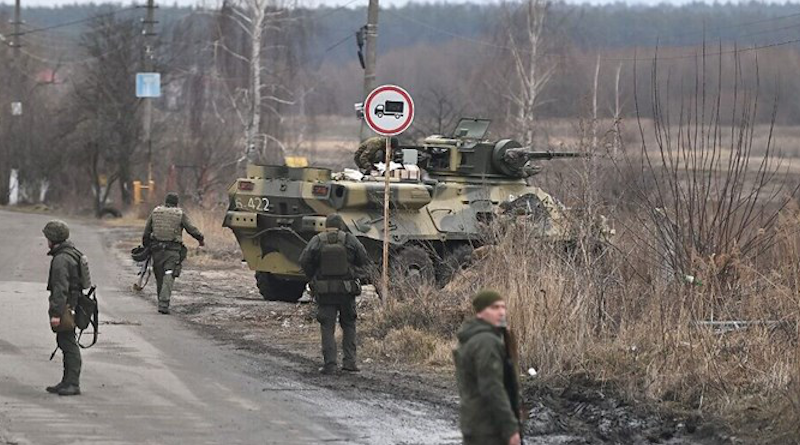
It may be only a matter of time before Russian troops control the Ukrainian capital of Kyiv and topple President Volodymyr Zelenskyy.
However, that may not be the end of the story. Russian President Vladimir Putin’s troops could find themselves in Ukraine for the long haul depending on whether Ukrainians have the stomach to launch an insurgency.
If so, Mr. Putin knows the drill. Soviet troops withdrew from Afghanistan in 1989 after a costly decade-long war in which they battled a US-Pakistani-Saudi-backed Islamic insurgency. Their defeat resembled the humiliation suffered by the United States at the hands of the Vietcong in the 1970s and the Afghan Taliban with last year’s US withdrawal from the Central Asian state.
As Ukrainians weigh their options for a post-Zelenskyy era, Chechnya, rather than Afghanistan, will likely be on their minds. Russian troops brutally quelled an Islamic insurgency in Chechnya in two wars. They besieged and devastated the Chechen capital of Grozny.
Ukrainians may be right to focus on Chechnya. Their country is not Afghanistan. It does not border on a country like Pakistan that would be willing to invite the wrath of Russia.
NATO members Poland, Romania, Hungary, and Slovakia, are unlikely to volunteer as Ukraine’s Pakistan. NATO expects its buildup along Russia’s European frontiers to deter Mr. Putin from expanding his war beyond Ukraine and is unlikely to want to give the Russian leader a blatant excuse. However, that would not stop NATO members from supporting a Ukrainian insurgency covertly.
Ukrainians may also look at Iraq as they consider their options. That could be more problematic for Mr. Putin. Elements of the Iraqi army, granted with the support of Iran and Syria, posed part of the backbone of the costly fight against the US presence in the country following the 2003 US-led invasion.
Mr. Putin may have had that in mind when he this week called on the Ukrainian military to seize power in their country in a bid to avoid an even bloodier battle than the fighting so far, particularly in Kyiv.
If Mr. Putin is betting on the fact that the Ukrainian military trained and armed itself to fight a conventional war like the Russian invasion, he may want to think twice. Iraq would suggest otherwise.
That is undoubtedly what proponents of a long-drawn-out insurgency believe.
“By combining serving military units with combat veterans, reservists, territorial defense units, and large numbers of volunteers, Ukraine can create tens of thousands of small and highly mobile groups capable of attacking Russian forces. This will make it virtually impossible for the Kremlin to establish any kind of administration over occupied areas or secure its lines of supply,” said former Ukraine defense minister Andriy Zagorodnyuk.
A poll conducted in December by the Kyiv International Institute of Sociology suggested that one in three Ukrainians would be willing to join an armed resistance against Russian forces.
Politics scholar Olexiy Haran, said after earlier in the day delivering food to defenders of Kyiv near his home, that volunteers led by military and former officers had already established irregular fighting units armed primarily with automatic weapons across the city.
“People are armed. Yesterday, 18,000 Kyivites took up arms. There are volunteer groups all around the city. They pursue any Russian soldier, paratrooper or subversive group that is trying to organize a provocation,” Mr. Haran said.
Russia scholars Michael Kofman and Jeffrey Edmonds may unwittingly have articulated Mr. Putin’s counter-argument and assumption when they argued in a Foreign Affairs article this week that a shift by the Ukrainian military from conventional to partisan warfare “is easier in theory than in practice.”
Messrs. Kofman and Edmonds reasoned further that partisan tactics would be less effective than past wars, presumably including former Yugoslavia and Iraq.
“These tactics would be less effective than in previous wars, thanks to the rise of new technologies, such as drones using thermal cameras and cheap, high-resolution satellite imaging. Today, small groups of fighters may struggle to hide and to win on the battlefield,” the two scholars wrote.
The same would be true for insurgents, as evident with Yemen’s Houthis.
Ukrainians would further benefit from the fact that Kyiv is not Grozny, and Ukraine is not Chechnya, where the world looked the other way in part because Russia was fighting an Islamist and jihadist insurgency. Mr. Putin’s assertion that he is fighting neo-Nazis and drug dealers in Kyiv have little international currency.
Abkhazia, one of two Russian-supported territories that broke away from Georgia in 2008, may be Mr. Putin’s best-case scenario. Abkhazia is wracked by political instability rather than insurgency and violence.
Anti-government protesters have demanded a halt to sales of real estate and energy assets to Russian nationals and a notion of a “shared sovereignty” between Abkhazia and Ukraine. They also denounced a proposed Russian-style law that would allow the government to label non-governmental organizations (NGOs), public figures, and media as foreign agents.
Abkhazia may be Ukraine’s least likely model, at least for the near future.
Nevertheless, whatever Ukrainians decide, a Russian occupation of Kyiv and replacement of Mr. Zelenskyy with a more Moscow-friendly figure is likely to be the beginning rather than the end of the story.
